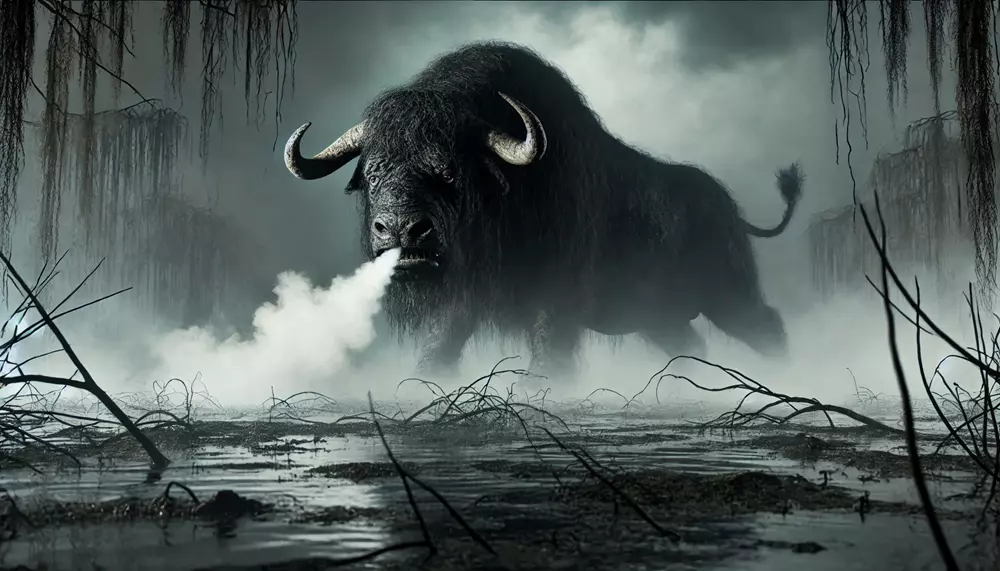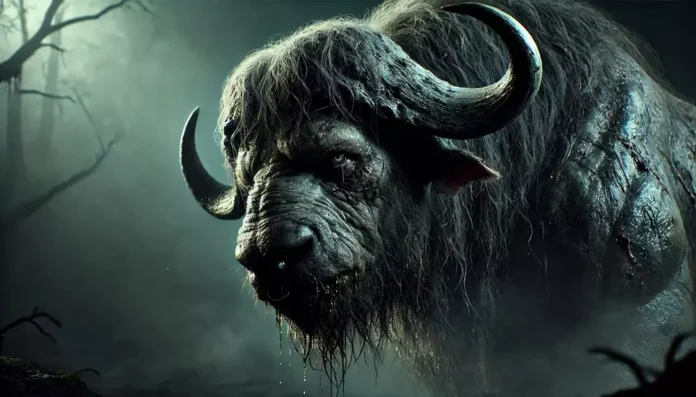Introduction
The Catoblepas is a creature steeped in legend, an animal with a gaze so toxic it can end life instantly. Its defining feature? A massive, drooping head that seems too heavy for its own neck. Ancient texts describe it as a bizarre mix of cow and boar, plodding through the swamps with a deadly, downcast stare. Known for its poisonous breath and paralyzing glare, this beast embodies the dangers lurking in murky lands. The Catoblepas has fascinated many, often standing as a symbol of nature’s unpredictable power, a reminder of the mysteries hidden in forgotten places.
History/Origin
First documented in the writings of Pliny the Elder around 77 AD, the Catoblepas is believed to have originated from North Africa, specifically Ethiopia. Pliny described it as a beast so foul and dangerous that it was best avoided at all costs. He compared its body to that of a bull but noted its downturned head and its almost mournful, passive stance. The name “Catoblepas” itself means “to look downward,” which suited its heavy-headed and lethargic nature.

In his work Naturalis Historia, Pliny detailed its deadliness: “It carries its head always lowered, for if it were raised, it would bring death to those who looked upon it.” This description sparked the idea that the creature’s gaze was lethal. Further mentions of the Catoblepas in medieval bestiaries fueled the myth, portraying it as a warning about the power of untamed, mysterious lands.
Name Meaning
The name “Catoblepas” comes from the Greek word katablépō, meaning “to look downward” or “to lower the gaze.” This name perfectly aligns with the creature’s posture, as ancient accounts frequently emphasize its heavy head that constantly droops toward the ground. In Greek, Κατοβλέπας (Katoblépas) refers to a creature resigned to its own weight, a symbolic feature that adds to the beast’s ominous allure. The name doesn’t merely describe its physical appearance but reinforces the belief in its deadly, downward gaze that no one could survive.
Appearance
The Catoblepas is often described as a monstrous beast resembling a blend of cow, buffalo, and boar. Its skin is dark and leathery, resembling thick hides built to withstand harsh conditions. It stands on four thick legs, with hooves that sink into swampy terrain. The creature’s most notable feature, however, is its oversized head, often depicted with a mane of bristly hair and large, sad eyes that seem perpetually downcast.
One might imagine the Catoblepas plodding along, its head so heavy that it’s forced to keep it lowered. Ancient sources like Pliny also claimed it had toxic breath, capable of withering plants and killing creatures within close range. This feature added a further layer of mystery and danger, giving the Catoblepas an aura of deadly passivity.
Background Story
According to myth, the Catoblepas roamed wild lands where humans dared not tread. Many stories portray it as a creature left alone, perhaps out of respect or sheer fear of its lethal powers. The beast’s passive demeanor added to its mystique—if it chose to look up, it could bring devastation with just a glance. However, its head remained bowed as if weighed down by an eternal sorrow or fatigue.

Some legends propose that the Catoblepas was created by the gods to guard hidden, untamed regions of the Earth. Its poisonous breath and lethal gaze were not just defenses; they were curses meant to remind intruders of nature’s wrath. Others claim the creature was part of the primordial chaos, an ancient being that existed before gods divided order from disorder. Its mere presence in a tale would evoke images of wild, foreboding landscapes, where humans learned quickly to stay clear.
Cultural Impact
In cultures that revered nature, the Catoblepas served as a warning about the unseen dangers of the wilderness. Some European societies during the medieval period used it as a cautionary figure in folklore, describing how those who wandered into certain marshlands might meet an unfortunate end at the hands of this beast. Medieval bestiaries brought the Catoblepas into Christian symbolism, viewing it as an embodiment of sin, lethargy, and death. Monks and scholars likened its deadly gaze to the corruption of the soul, a reminder to the faithful of the importance of vigilance and purity.
In Ethiopia and other parts of Africa, where similar creatures might have inspired the myth, the Catoblepas represented the mysterious and untamable side of nature. It emphasized the value of respecting one’s environment and warned of the risks in disturbing the balance between humans and the wild.
“The eyes of the Catoblepas hold death itself. They bear a sorrow so deep that only death can end it.” This quote from a medieval bestiary reflects the creature’s association with lethargy and despair, seen as spiritual dangers as well as physical.
Similar Beasts
The Catoblepas shares traits with several other mythical creatures, particularly the basilisk and the gorgon. The basilisk, also known for its lethal gaze, shares the Catoblepas’s association with deadly vision. Gorgons, like Medusa, can turn onlookers to stone with their gaze, reflecting similar themes of petrifying horror.
Another creature, the chimera, shares its composite nature with the Catoblepas. While not sharing the exact traits of toxicity, the chimera’s mismatched body parts echo the chaotic mix of animalistic features seen in Catoblepas descriptions. The African wildebeest, too, might be a real-life inspiration due to its head-heavy build and lethargic behavior.
Religion/Ritual
The Catoblepas never gained much prominence in major religious rituals, yet it held a unique place in local folklore and was symbolically tied to death and decay. Some folklore suggests that people avoided certain lands, believing the Catoblepas guarded sacred, forbidden places. In these tales, swamps and marshes represented the edges of the human world, inhabited by forces too powerful or strange to confront.
In a more metaphorical sense, some Christian scholars viewed the Catoblepas as an allegory for sin and slothfulness. Monks and theologians discussed the creature’s lethargy, drooping head, and dangerous gaze as reflections of spiritual dangers, warning against apathy and the temptations of the flesh.
“The beast of the swamp lures only the weary, those who seek but lack the will to act,” wrote a monk in the 12th century, linking the Catoblepas to moral failing.
Scientific or Rational Explanations
Scholars and historians have speculated that real animals might have inspired the Catoblepas legend. Some suggest it was based on the African wildebeest, which has a heavy, bowed head and is native to the region around Ethiopia, where the myth originated. The wildebeest’s appearance, particularly when exhausted or wounded, might have contributed to stories about a creature too heavy-headed to lift its gaze.
Others propose that the myth could reflect a misunderstanding of local fauna or possibly an exaggerated traveler’s tale. Ancient explorers returning from Africa might have relayed stories of strange beasts with dangerous characteristics, which grew with each retelling. Additionally, some historians believe that the Catoblepas’s toxic breath and gaze could be symbolic of malaria or other swamp-borne illnesses, which were common in the regions where the creature was said to roam.
Modern Cultural References
The Catoblepas appears in various modern media, often as a formidable or haunting creature that brings doom upon those who encounter it. Here are a few notable examples:
Dungeons & Dragons: The Catoblepas is featured as a challenging adversary in D&D campaigns, characterized by its heavy head and toxic breath.
The Witcher Series: In the game, Catoblepas meat is used in various alchemical recipes, highlighting the creature’s mythical rarity.
Magic: The Gathering: The card game features a creature card inspired by the Catoblepas, combining elements of lethargy and death.
Castlevania Series: The Catoblepas appears as a formidable enemy, reflecting its traditional toxic and deadly nature.
Persona Series: The Catoblepas appears as a summonable creature with a deadly aura, embodying lethargy and doom.
“A monster from a forgotten time, lurking in darkness, awaiting the weary,” an inscription from a Castlevania game portrays the Catoblepas as a lurking predator, a creature whose power is both frightening and alluring.
Conclusion
The Catoblepas remains a compelling figure in myth and popular culture, embodying the mystique of untamed, dangerous lands and the dangers that lie within them. Its characteristics, from its poisonous breath to its lethal gaze, serve as powerful symbols of nature’s unpredictability and the perils awaiting those who wander too far. This creature, with its haunting look and lethargic stance, reminds us of the boundaries we must respect and the mysteries we may never fully understand. Through its evolution from Pliny’s writings to modern media, the Catoblepas continues to capture imaginations, a beast forever looming at the edge of myth and reality.











